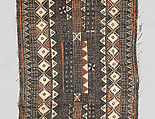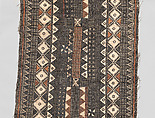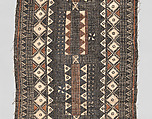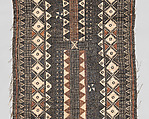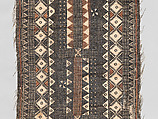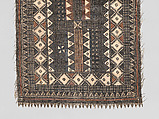Painted Barkcloth (Masi kesa)
Not on view
This richly patterned textile from the Lau Islands in Fiji exhibits the complex imagery typical of many examples of Polynesian barkcloth. Often referred to using the general term tapa, barkcloth is a clothlike material derived from the inner bark of certain species of tree. Practiced exclusively by women, tapa making is one of the most important and diverse art forms in Polynesia. Both now and in the past, the display and exchange of large pieces of tapa form important components of ceremonial life in many areas of Polynesia. In earlier times, tapa was also among the primary materials used for clothing.
The creation of tapa is accomplished in several stages. Women initially remove small strips of bark from the tree, which are soaked in water and treated to make them soft and pliable. Using clublike wooden implements known as tapa beaters, they later beat the strips on a long rectangular block or "anvil" to form individual pieces of cloth. The edges of these smaller pieces are then overlapped and beaten again so that their fibers fuse, forming large sheets.
The finished tapa is decorated using techniques that vary from region to region. These include stencilling (as in the present example), printing, dyeing, and freehand painting. The repeating geometric motifs of many tapa cloths at times resemble those seen on pottery produced by the Lapita peoples, who were the ancestors of present-day Polynesians. This has led some scholars to suggest that the designs seen in some contemporary Polynesian tapa and tattoos reflect the continuity of earlier Lapita prototypes.
Due to rights restrictions, this image cannot be enlarged, viewed at full screen, or downloaded.
This artwork is meant to be viewed from right to left. Scroll left to view more.



